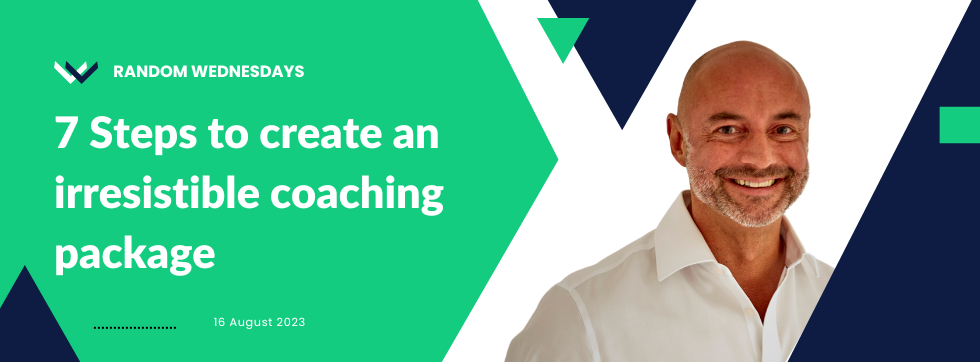It’s simple.
All you’ve got to do is craft the ideal coaching package.
Make sure it resonates, stands out in a sea of mediocrity and is utterly irresistible to clients.
Oh and don’t forget it’s got to deliver exceptional value too.
Sounds simple but it’s far from easy.
Designing a compelling package hinges on your ability to not only serve but captivate.
The problem is most coaches miss what clients are looking for.
Relying on a combination of guesswork, intuition and experience will only take you so far.
It’s time to shift from generic offerings to creating real, tangible value.
Let’s jump in.
#1. Reserve a seat for your client
“Start with the customer and work backward” Jeff Bezos once remarked.
Amazon’s ex-CEO was famous for having an empty chair at company meetings. It represented The Customer: “the most important person in the room.”
Cheesy, but it’s hugely helpful to picture your client when capturing your ideas and thoughts.
The empty chair is a reminder to align everything you do with your client’s goals, aspirations and wants.
Reserving a seat is a powerful first step in designing your package with your client ‘present’.
#2. Value proposition design: a new perspective
Next, it’s time to define your value proposition.
Detailing and visualising the benefits your clients can expect from your service.
The best tool I’ve found to support this process is the Value Proposition Canvas by Strategyzer.
This is my go to resource whenever I’m working with clients in this area.
Download the Value Proposition Canvas – FREE
A value proposition comprises two parts.
- Understanding your client (Client Profile)
- Knowing how you intend to create value for them. (Value Map)
Once you’ve met in the middle, you’ve achieved a “Fit”.
In other words, the more you understand your client the better you’ll be able to tailor your package and click.
#3. Create your customer profile
Keep in mind your ideal client seated in front of you.
Have the Value Proposition Canvas or a pen and paper handy.
Sketch out a Client Profile, splitting this into three areas:
- Client jobs
- Client gains
- Client pains
From your clients perspective (not yours) focus on three areas:
1. Client “Jobs” – things clients want to do
- What are the things they’re trying to get done in their lives or at work?
- What tasks are they trying to perform and complete?
- What problems are they trying to solve or needs they’re trying to meet?
These might be:
Functional – task completion or problem solving
Social – gaining status, power or looking good
Emotional – seeking an emotional state; feeling confident etc
Download Client Jobs Trigger Questions
2. Client “Gains” – outcomes clients wish to happen
- What are the outcomes or best case scenarios clients want to achieve?
- What are the specific benefits they desire?
These might be:
Required – basic expectations or ‘table stakes’ deemed as least required
Expected – basic gains expected though not essential
Desired – gains beyond the expected
Unexpected – gains that go above and beyond, which are totally unexpected
Download Client Gains Trigger Questions
3. Client “Pains” – outcomes clients wish to avoid
- What are the pain points, obstacles, risks or bad outcomes related to their ‘jobs’?
- What’s preventing them from completing something or moving on?
These might be
Undesired outcomes – things clients don’t want to feel or experience
Obstacles – things that are in the way; physically, emotionally or mentally
Risks – perceived risks and consequences
Download Client Pains Trigger Questions
#4. Rank your findings
Next, rank your client’s jobs, pains and gains to prioritise the things that matter most to them.
An effective approach is to create three columns on your page.
For each area, rank your findings in descending order:
- Jobs – rank jobs from most important to least important
- Pains – rank pains from extreme to moderate
- Gains – rank gains from essential to nice to have
This may feel tricky at first, especially if you don’t have a long client list.
Stick with it.
After every client interaction, experience and reflection your understanding will significantly improve.
It’s important to test each ranking until it reflects the priorities from the customer’s view.
This way you’ll have a clearer client profile and a much better understanding of them.
#5. Draw your Value Proposition Map
Now it’s time to focus on you and create your Value Map.
Make a list of your services and any products you offer. Everything that’s in your shop window.
Outline how your services will ease client pains.
How will they reduce undesired outcomes, obstacles or risks?
Tip: Great value propositions focus on pains that matter most to customers. The more extreme the better.
Download Client Pains Relievers Questions
Next explain how your service currently creates customer gains.
Detail the desired outcomes or benefits your clients expect to receive.
Tip: Focus your efforts on the top 3-5 gains that make the biggest difference.
Download Client Gains Creators Questions
Finally, as in #4 – rank each of your services or products, pain relievers and gain creators. Map how essential they are to your client.
#6. Check the fit
This is where the magic happens.
A fit is when your clients become energetically connected with your value proposition.
They can see and feel you’ve captured what they absolutely care about:
Specifically you’ve:
- Addressed their most important jobs
- Alleviated their most extreme pains
- Created their most essential gains
#7 Three stages of fit
To check your fit, have your ideal Customer Profile and Value Proposition Map in front of you.
Go through the pain relievers and gain creators one by one and check to see if they fit a customer job, pain or gain.
If a pain reliever or gain creator doesn’t fit, it may not be creating customer value.
There are three stages of “Fit”
- Paper Fit: looks good on paper but you don’t have any evidence clients actually care
- Market Fit: you seek market evidence to confirm or invalidate your assumptions
- Bank fit – clients find your value proposition irresistible. It becomes part of your profitable business model
The goal is to ensure your proposition covers the headaches that matter most and the gains that make the most difference.
Conclusion
Creating an irresistible coaching package might appear daunting at first
But starting with a client focused, Value Based Proposition is critical to success.
Consider revisiting your current packages or design a new one through the lens of “Value Proposition Design”.
Begin by:
- Focusing on one value proposition for a specific client on a single map
- Deeply profile at least three of your past or current clients.
- Identify gaps in your current package.
- Refine and redesign your offer.
It’s time to stand out, resonate, and become the go-to coach that clients can’t resist.
This week’s action step
Download the Value Proposition Canvas.
- Start with client jobs
- Add pains and gains
- List your services and products
- Outline how you intend to create value
- Test the Fit.
If you want some help or support in tailoring an irresistible coaching package. Feel free to reach out and connect with me today.


